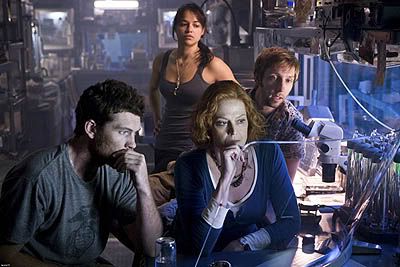Filmmaker James Cameron proclaimed himself the “king of the world” when “Titanic,” which had already sailed to the top of the all-time box office, won 11 Academy Awards. Twelve years later, in his first narrative film since then, he may not be the king of THE world, but he’s certainly the king of A world.
That would be Pandora, the alien setting of “Avatar,” a movie that raises the special effects bar to a new level. It’s actually a moon dominated by lush forests, floating mountains and exotic creatures—all bathed in a gorgeous neon glow and all the work of the computer wizards of Peter Jackson’s Oscar-winning effects house, WETA Digital. The level of detail is unprecedented. It is not just pretty scenery for us to “ooh” and “ah” at—Pandora is alive. It looks a feels like a real place with real inhabitants.
Earth, on the other hand, is dying. The year is 2154, and a human mining colony has been established on far-off Pandora. A mineral found there, called Unobtainium, is the key to Earth’s survival, and the Resources Development Administration, with a mercenary military unit at its disposal, is determined to get to it by any means necessary. The biggest deposit of it lies underneath the home of the Na’vi, Pandora’s 10-foot-tall, blue-skinned indigenous people.
Jake Sully (“Terminator Salvation’s” Sam Worthington), a Marine confined to a wheelchair, comes to Pandora to replace his deceased twin brother, a scientist, joining a team led by Dr. Grace Augustine (Sigourney Weaver). Using genetically engineered bodies—“avatars”—which they control while in a sleep-like state back at their outpost, they are able to walk among the Na’vi—Pandora’s atmosphere is toxic to humans—and study them. Though the scientists’ mission is one of friendship, Col. Miles Quaritch (Stephen Lang), leader of the RDA forces, recruits Jake, with the promise of restoring the use of his legs, as a spy, to either convince the Na’vi to move or set them up for their annihilation.
The Na’vi take Jake in to show him their ways, the clan leader’s (Wes Studi) daughter, Neytiri (Zoe Saldana, Uhura from this year’s “Star Trek”), serving as his teacher. As he learns of their reverence of and connection to the natural world around them, Jake learns to appreciate the Na’vi ways, developing an affinity of his own. Though some of the clan is distrustful, Jake becomes more and more Na’vi every day and falls hard for Neytiri.
Change the Na’vi to Native Americans—which wouldn’t be hard, given their clothing and customs—and it’s the kind of story we’ve seen many times before. But it’s told with conviction, its environmentalist message and love story timeless.
The Na’vi themselves are the movie’s greatest technological achievement, created through a performance capture technique similar to that used for Gollum in “The Lord of the Rings” and King Kong in the 2005 “King Kong” remake. The key advancement is the use of small cameras mounted in front of the actors’ faces, capturing every subtle tic and movement—even of the eyes, a problem no filmmaker has been able to truly solve until now. The result is that even though they have long necks and a feline quality to their faces, and stand so tall and slender, the actors give real performances. The effects works is so exquisite, so photo-real, that you’ll recognize Worthington, Weaver and Saldana.
As Neytiri, Saldana continues Cameron’s tradition of strong female characters, following in the footsteps of Linda Hamilton in “The Terminator” and “Terminator 2: Judgment Day” and Weaver in “Aliens.” Worthington delivers a star-making performance of his own, as Jake makes a natural transition from gung-ho Marine to steadfast defender of the Na’vi.

“Avatar” also makes the best use of 3D I have seen to date. Cameron does not employ it as gimmick—there’s no poking or throwing things at the audience. Rather than draw attention to itself, the effect draws us into the story, into this alien world, making the movie a truly immersive experience. I recommend seeing this one in 3D.
The story starts a bit slow, which probably should be expected with a 160-minute running time. Try not to get frustrated by the lack of a real explanation of what happened on Earth and how exactly the Unobtainium will help; it’s all merely a MacGuffin. Just roll with it, take in the incredible sights and you’ll be fine. By the time you get to the final battle, which consumes most of the movie’s final hour and is as thrilling as anything I’ve ever seen, it all will be worth it.
Cameron originally conceived the story in 1995, then waited and developed the technology necessary to bring his vision to life. Though no official figures have been released on the film’s budget, it is said to dwarf the $200-million price tag of “Titanic,” which at the time was the most expensive movie ever made.
“Avatar” is a huge gamble—maybe the biggest in film history. But creatively, artistically and technologically, it is a smashing success, providing the kind of experience that defines the term “event movie.” Long live the king.
Grade: A
(Rated PG-13 for intense epic battle sequences and warfare, sensuality, language and some smoking. 162 minutes.)
1 comment:
stooooooooked to see this
Post a Comment